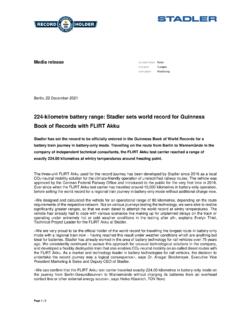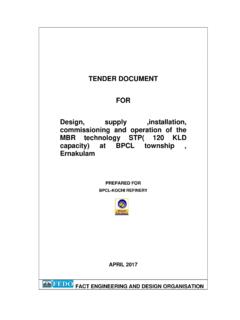Transcription of IMPORTANT SAFETY INSTRUCTIONS - Battery Tender
1 1 IMPORTANT SAFETY INSTRUCTIONS 1) SAVE THESE INSTRUCTIONS 2) Do not expose charger to rain or snow. 3) Use of an attachment not recommended or sold by the Battery charger manufacturer may result in a risk of fire, electric shock, or injury to persons. 4) To reduce risk of damage to electric plug and cord, pull by plug rather than cord when disconnecting charger. 5) An extension cord should not be used unless absolutely necessary. Use of improper extension cord could result in a risk of fire and electric shock. If an extension cord must be used, make sure: a) That pins on plug of extension cord are the same number, size, and shape as those of plug on charger; b) That extension cord is properly wired and in good electrical condition; and c) That wire size is large enough for ac ampere rating of charger as specified in Table 1 6) Do not operate charger with damaged cord or plug replace the cord or plug immediately.
2 7) Do not operate charger if it has received a sharp blow, been dropped, or otherwise damaged in any way; take it to a qualified serviceman. 8) Do not disassemble charger; take it to a qualified serviceman when service or repair is required. Incorrect reassembly may result in a risk of electric shock or fire. 9) To reduce risk of electric shock, unplug charger from outlet before attempting any maintenance or cleaning. Turning off controls will not reduce this risk. 10) WARNING RISK OF EXPLOSIVE GASES. a) WORKING IN VICINITY OF A LEAD-ACID Battery IS DANGEROUS. BATTERIES GENERATE EXPLOSIVE GASES DURING NORMAL Battery OPERATION. FOR THIS REASON, IT IS OF UTMOST IMPORTANCE THAT YOU FOLLOW THE INSTRUCTIONS EACH TIME YOU USE THE CHARGER.
3 B) To reduce risk of Battery explosion, follow these INSTRUCTIONS and those published by Battery manufacturer and manufacturer of any equipment you intend to use in vicinity of Battery . Review cautionary marking on these products and on engine. 11) PERSONAL PRECAUTIONS a) Consider having someone close enough by to come to your aid when you work near a lead-acid Battery . b) Have plenty of fresh water and soap nearby in case Battery acid contacts skin, clothing, or eyes. c) Wear complete eye protection and clothing protection. Avoid touching eyes while working near Battery . d) If Battery acid contacts skin or clothing, wash immediately with soap and water.
4 If acid enters eye, immediately flood eye with running cold water for at least 10 minutes and get medical attention immediately. e) NEVER smoke or allow a spark or flame in vicinity of Battery or engine. Deltran Battery Tender Junior Designed for six cell lead-acid batteries TABLE 1 Length of Cord, Feet 25 50 100 150 AWG Size of Cord 18 18 18 16 P/N 392-0247-RE 2 f) Be extra cautious to reduce risk of dropping a metal tool onto Battery . It might spark or short-circuit Battery or other electrical part that may cause explosion. g) Remove personal metal items such as rings, bracelets, necklaces, and watches when working with a lead-acid Battery .
5 A lead-acid Battery can produce a short-circuit current high enough to weld a ring or the like to metal, causing a severe burn. h) Use charger for charging a LEAD-ACID Battery only. It is not intended to supply power to a low voltage electrical system other than in a starter-motor application. Do not use Battery charger for charging dry-cell batteries that are commonly used with home appliances. These batteries may burst and cause injury to persons and damage to property. i) NEVER charge a frozen Battery . 12) PREPARING TO CHARGE a) If necessary to remove Battery from vehicle to charge, always remove grounded terminal from Battery first. Make sure all accessories in the vehicle are off, so as not to cause an arc.
6 B) Be sure area around Battery is well ventilated while Battery is being charged. c) Clean Battery terminals. Be careful to keep corrosion from coming in contact with eyes. d) Add distilled water in each cell until Battery acid reaches level specified by Battery manufacturer. Do not overfill. For a Battery without removable cell caps, such as valve regulated lead acid batteries, carefully follow manufacturer s recharging INSTRUCTIONS . e) Study all Battery manufacturer s specific precautions such as removing or not removing cell caps while charging and recommended rates of charge. f) Determine voltage of Battery by referring to car owner s manual. Do not use the Battery charger unless Battery voltage matches the output voltage rating of the charger.
7 13) CHARGER LOCATION a) Locate charger as far away from Battery as dc cables permit. b) Never place charger directly above Battery being charged; gases from Battery will corrode and damage charger. c) Never allow Battery acid to drip on charger when reading electrolyte specific gravity or filling Battery . d) Do not operate charger in a closed-in area or restrict ventilation in any way. e) Do not set a Battery on top of charger. 14) DC CONNECTION PRECAUTIONS a) Connect and disconnect dc output clips only after setting any charger switches to off position and removing ac cord from electric outlet. Never allow clips to touch each other. b) Attach clips to Battery and chassis as indicated in 15(e), 15(f), and 16(b) through 16(d).
8 15) FOLLOW THESE STEPS WHEN Battery IS INSTALLED IN VEHICLE. A SPARK NEAR Battery MAY CAUSE Battery EXPLOSION. TO REDUCE RISK OF A SPARK NEAR Battery : a) Position ac and dc cords to reduce risk of damage by hood, door, or moving engine part. b) Stay clear of fan blades, belts, pulleys, and other parts that can cause injury to persons. c) Check polarity of Battery posts. POSITIVE (POS, P, +) Battery post usually has larger diameter than NEGATIVE (NEG, N, ) post. d) Determine which post of Battery is grounded (connected) to the chassis. If negative post is grounded to chassis (as in most vehicles), see (e). If positive post is grounded to the chassis, see (f). e) For negative-grounded vehicle, connect POSITIVE (RED) clip from Battery charger to POSITIVE (POS, P, +) ungrounded post of Battery .
9 Connect NEGATIVE (BLACK) clip to vehicle chassis or engine block away from Battery . Do not connect clip to carburetor, fuel lines, or sheet-metal body parts. Connect to a heavy gage metal part of the frame or engine block. 3 f) For positive-grounded vehicle, connect NEGATIVE (BLACK) clip from Battery charger to NEGATIVE (NEG, N, ) ungrounded post of Battery . Connect POSITIVE (RED) clip to vehicle chassis or engine block away from Battery . Do not connect clip to carburetor, fuel lines, or sheet-metal body parts. Connect to a heavy gage metal part of the frame or engine block. g) When disconnecting charger, turn switches to off, disconnect AC cord, remove clip from vehicle chassis, and then remove clip from Battery terminal.
10 H) See operating INSTRUCTIONS for length of charge information. 16) FOLLOW THESE STEPS WHEN Battery IS OUTSIDE VEHICLE. A SPARK NEAR THE Battery MAY CAUSE Battery EXPLOSION. TO REDUCE RISK OF A SPARK NEAR Battery : a) Check polarity of Battery posts. POSITIVE (POS, P, +) Battery post usually has a larger diameter than NEGATIVE (NEG, N, ) post. b) Attach at least a 24-inch-long 6-gauge (AWG) insulated Battery cable to NEGATIVE (NEG, N, ) Battery post. c) Connect POSITIVE (RED) charger clip to POSITIVE (POS, P, +) post of Battery . d) Position yourself and free end of cable as far away from Battery as possible then connect NEGATIVE (BLACK) charger clip to free end of cable.






